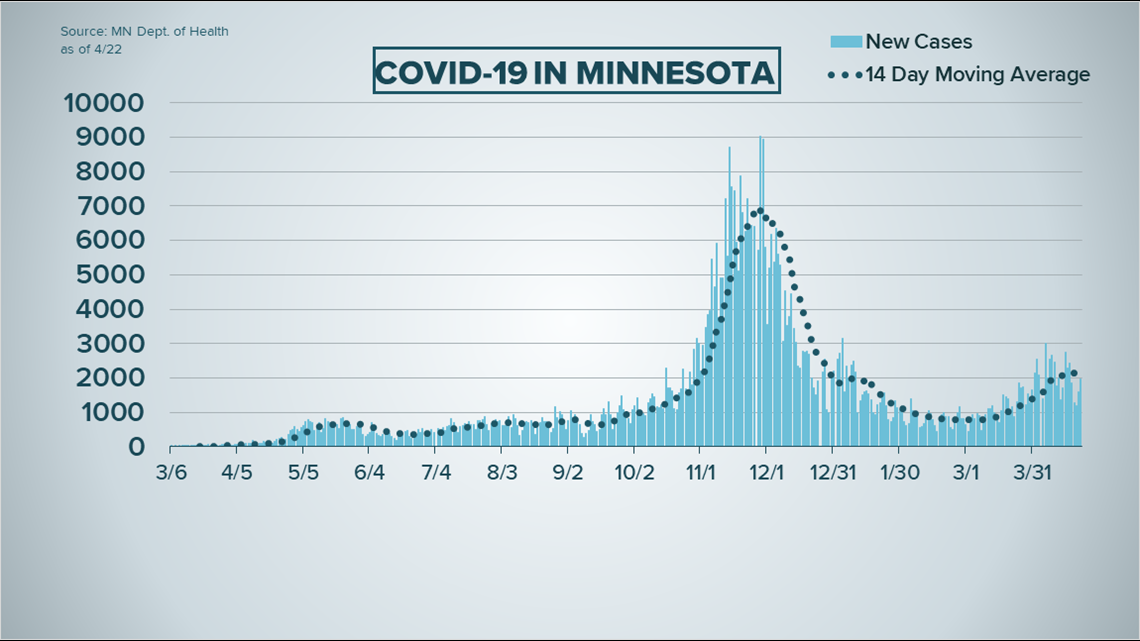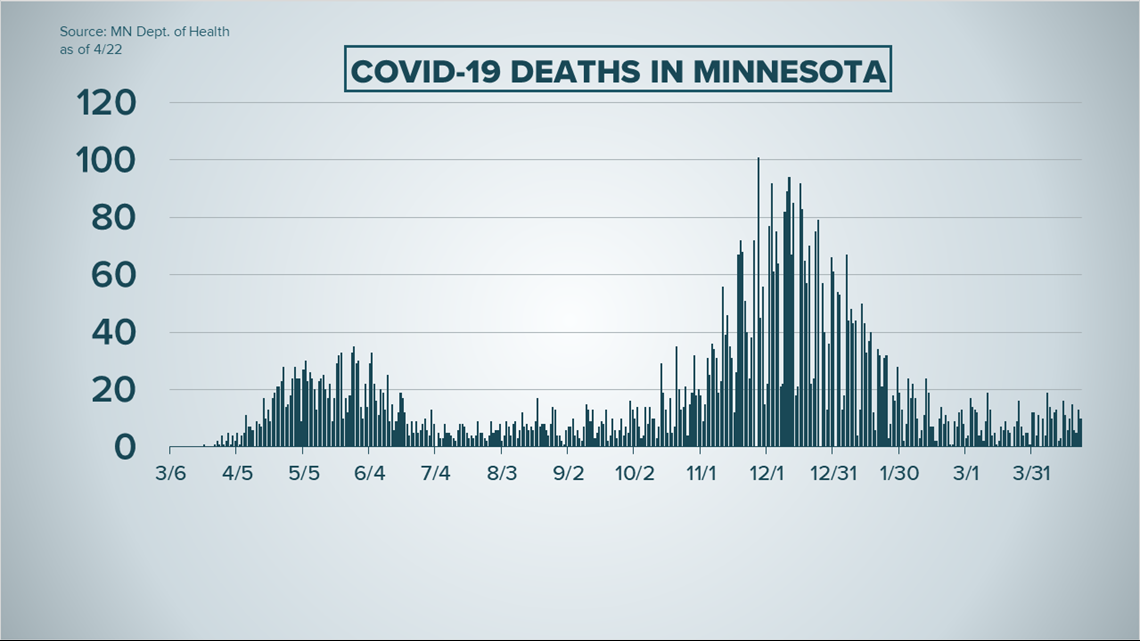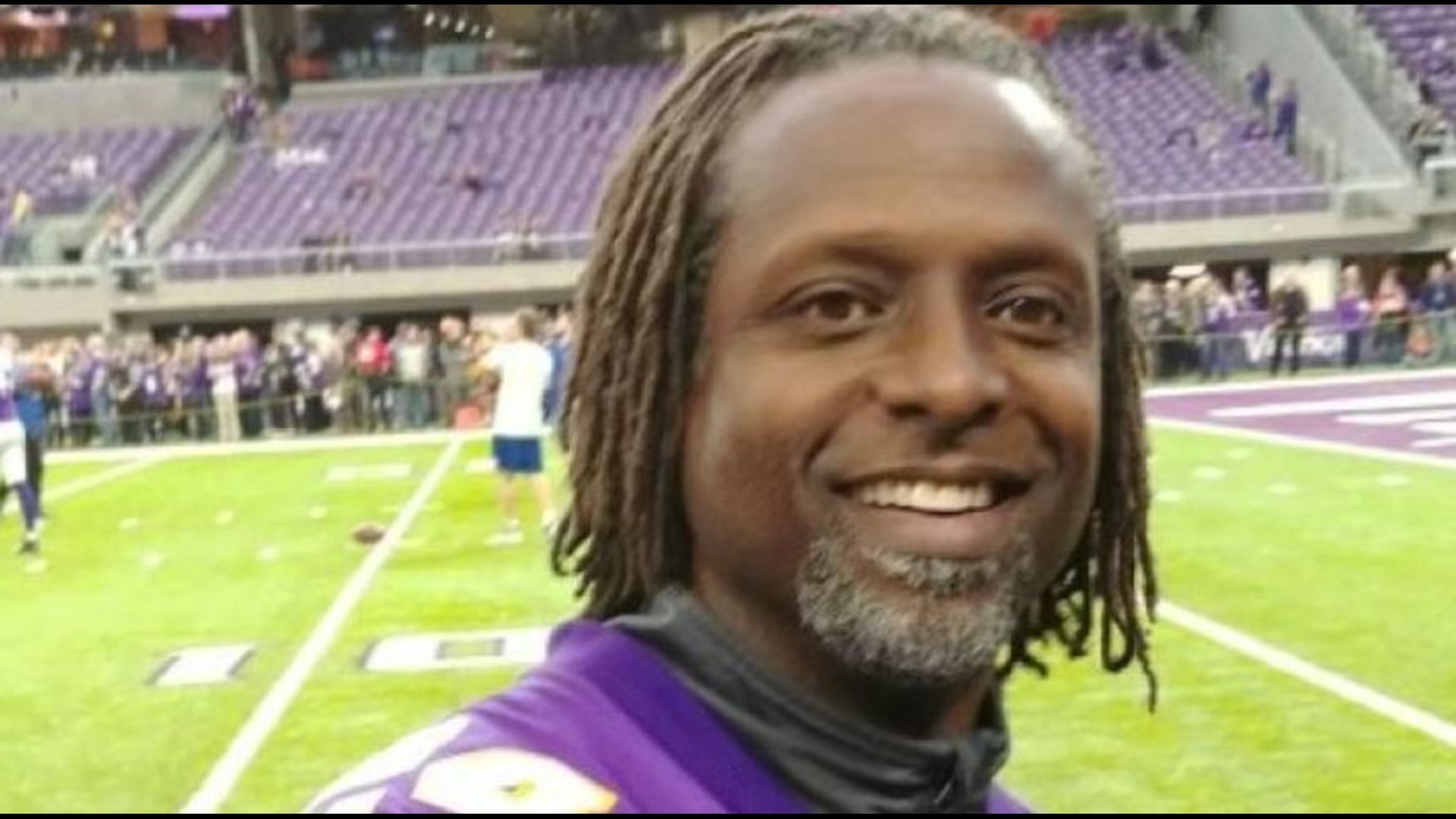ST PAUL, Minn. — Thursday, April 22
- MDH officials urge weekly COVID-19 testing for student athletes amid spike in school-related cases
- Masks optional during outdoor games for spring sports
- Minnesota unveils new Mobile Vaccination Units
- All U.S. adults now vaccine eligible
- Minnesota passes 7,000 reported COVID-19 deaths
11 a.m.
Top Minnesota health and education officials are urging more frequent COVID-19 testing among student athletes as the state grapples with a surge in the number of school-related cases.
"Just this week, we've seen the number of school-related COVID-19 cases in students exceed the high level set in November, during the big fall surge," MDH Commissioner Jan Malcolm said during a briefing with reporters Thursday. "That means we've got a lot of work to do to ensure community transmission goes back down."
Starting Monday, April 26, the State of Minnesota is increasing testing efforts in support of giving local students "the best chance to successfully conclude their school year with in-person learning," Malcolm said.
Malcolm emphasized the continuing need for every student in middle and high school to get tested for COVID-19 every two weeks, regardless of their participation in extra-curricular activities. She said MDH is now encouraging all student athletes and Minnesotans of all ages who play organized sports to get tested every week.
"Testing on a regular basis allows schools and teams to catch cases early, and to keep them from spreading undetected. It prevents an isolated problem from becoming a much bigger problem, that drags down a whole school, a team, or a season," she said.
The state will provide free COVID-19 saliva test kits for any middle and high school, as well as sports teams, through its partnership with Vault Health.
Education officials are encouraging schools to offer onsite testing.
"The ability to offer COVID-19 testing through our middle and high schools is one more tool to ensure our students can continue safely learning in-person," Minnesota Education Commissioner Dr. Heather Mueller said.
Commissioner Malcolm also announced a change in its face covering recommendations, and will now permit those who play outdoor sports to remove masks during games.
The changes to mask-wearing rules for student athletes follows a similar request from the Minnesota State High School League board last week. The board asked state health officials to allow athletes to compete outdoors without wearing masks this spring. The recommendation required athletes to wear masks during breaks before and after competitions, and while on the sidelines, which the state adopted.
Minnesota officials clarified that athletes must wear face coverings any time they're "not actively playing."
Meanwhile, data released in Thursday’s daily report by the Minnesota Department of Health (MDH) shows that both COVID-19 hospitalizations and cases are slightly up.
Currently 683 people are being treated for the virus in hospitals across Minnesota, with 196 of those patients requiring ICU care. With hospitalizations up, beds in the Twin Cities system are scarce with just 54 non-ICU beds open, a 1.5% vacancy rate.
Total hospitalizations are up to 29,477, with 6,006 of those patients needing ICU treatment. MDH says 538,450 people who tested positive for the virus at one time have recovered to the point they no longer need to isolate.
MDH recorded 1,973 new infections in the last day, bringing total cases in Minnesota to 562,420 since the pandemic began. Those new cases are based on results from 43,829 tests (36,448 PCR, 7,381 antigen) processed in private and state labs.


Minnesota’s four most populous counties also have the highest COVID numbers: Hennepin County has recorded 117,078 cases and 1,693 deaths, followed by Ramsey County with 48,500 cases and 859 deaths, Dakota County with 43,135 cases and 425 deaths, and Anoka County with 39,159 cases and 430 deaths.
Ten more COVID-related deaths have been reported in the last day, bringing fatalities to 7,054. Of those deaths 4,343 (61%) are tied to assisted living or long-term care settings.


The effort to vaccinate all Minnesotans against the virus continues, with 2,349,782 residents having been immunized with at least one dose, 53.3% of the state’s eligible population. MDH says 1,674,765 people have completed their COVID shot series and are considered fully immunized. That’s 38% of the population currently scheduled to be immunized.
Hear the full MDH briefing in the player below:
Wednesday, April 21
11 a.m.
COVID-related ICU hospitalizations are the highest they've been since late December, according to data released Wednesday by the Minnesota Department of Health (MDH).
As of Tuesday 193 people were receiving intensive care treatment for the virus in hospitals across Minnesota, the same number MDH reported for Monday. Currently 676 people total are being treated for COVID on an inpatient basis.
Total hospitalizations are now at 29,372 since the onset of the pandemic.
On Wednesday MDH spokesman Doug Schultz said the department believes that the spike in both cases and hospitalizations is being driven partly by the spread of variant COVID strains. He estimates that at least 50% of the new cases involve variants, especially the B.1.1.7.
Schulz says the science is clear that B.1.1.7 is more easily spread, and two recent studies from the United Kingdom suggest the variant causes more severe disease. That being said, MDH scientists believe other factors are likely at play, like more people gathering in various social settings, and relaxing their use of masks and social distancing.
"While more people are being vaccinated every day – and that’s good news – we are also seeing increasing cases, positivity rates and hospitalization rates, with the hospitalized population trending younger than before/during the previous surge," Schultz says. "So it’s important that all Minnesotans continue to follow guidelines for wearing masks, social distancing, testing and staying home if you’re positive, staying home when you’re ill, and washing hands, covering your coughs and sneezes."
MDH has recorded 1,611 new COVID cases in the past day, based on 24,501 tests (20,957 PCR, 3,544 antigen) processed in private and state labs. A positive PCR test is considered a confirmed COVID case, while a positive antigen test is considered probable.
Minnesota's total coronavirus cases now sit at 560,450, with 36,390 of them tied to antigen tests. MDH says 537,130 people who at one time tested positive for the virus have improved to the point they no longer need to be isolated.
Another 13 lives have been lost to COVID, bringing total fatalities in the state to 7,044. The virus has been most deadly for those in the 85 to 89 age group, with 1,308 deaths in just 6,592 diagnosed cases. Young adults between 20 and 24 are linked to the largest grouping of cases with 54,646, with four of those people dying from COVID.
The effort to immunize every person in the state continues with 1,648,311 people considered completely vaccinated as of Monday after completing their COVID shot series. That's 37.4% of those eligible to be vaccinated. The vaccine dashboard says 2,324,241 people have received at least one shot, 52.7% of those eligible.
iOS 12 One Month Later - Should You Install the Beta?
FEATURED BY
COVID-related ICU hospitalizations are the highest they've been since late December, according to data released Wednesday by the Minnesota Department of Health (MDH).
As of Tuesday 193 people were receiving intensive care treatment for the virus in hospitals across Minnesota, the same number MDH reported for Monday. Currently 676 people total are being treated for COVID on an inpatient basis.
Total hospitalizations are now at 29,372 since the onset of the pandemic.
On Wednesday MDH spokesman Doug Schultz said the department believes that the spike in both cases and hospitalizations is being driven partly by the spread of variant COVID strains. He estimates that at least 50% of the new cases involve variants, especially the B.1.1.7.
Schulz says the science is clear that B.1.1.7 is more easily spread, and two recent studies from the United Kingdom suggest the variant causes more severe disease. That being said, MDH scientists believe other factors are likely at play, like more people gathering in various social settings, and relaxing their use of masks and social distancing.
"While more people are being vaccinated every day – and that’s good news – we are also seeing increasing cases, positivity rates and hospitalization rates, with the hospitalized population trending younger than before/during the previous surge," Schultz says. "So it’s important that all Minnesotans continue to follow guidelines for wearing masks, social distancing, testing and staying home if you’re positive, staying home when you’re ill, and washing hands, covering your coughs and sneezes."
MDH has recorded 1,611 new COVID cases in the past day, based on 24,501 tests (20,957 PCR, 3,544 antigen) processed in private and state labs. A positive PCR test is considered a confirmed COVID case, while a positive antigen test is considered probable.
Minnesota's total coronavirus cases now sit at 560,450, with 36,390 of them tied to antigen tests. MDH says 537,130 people who at one time tested positive for the virus have improved to the point they no longer need to be isolated.
Credit: KARE
Another 13 lives have been lost to COVID, bringing total fatalities in the state to 7,044. The virus has been most deadly for those in the 85 to 89 age group, with 1,308 deaths in just 6,592 diagnosed cases. Young adults between 20 and 24 are linked to the largest grouping of cases with 54,646, with four of those people dying from COVID.
Credit: KARE
The effort to immunize every person in the state continues with 1,648,311 people considered completely vaccinated as of Monday after completing their COVID shot series. That's 37.4% of those eligible to be vaccinated. The vaccine dashboard says 2,324,241 people have received at least one shot, 52.7% of those eligible.
Credit: KARE
Tuesday, April 20
11 a.m.
While data released Tuesday by the Minnesota Department of Health (MDH) shows new daily COVID cases down significantly from last week (several days above the 2,000 threshold), state officials remain concerned about both cases and hospitalization numbers currently associated with the virus.
MDH says 686 people were being treated in hospitals across the state Monday, with 193 of them in the ICU. That's the highest number of daily ICU patients reported since Dec. 30.
While reported new infections are at 1,189, significantly lower than in recent days, it's also important to note that Tuesday's reported numbers are generally the lowest of the week. Health commissioner Jan Malcolm says her staff remains extremely concerned about the long term trends they're seeing, especially with hospitalizations. She noted that MDH has not seen numbers like this since December, and the emergence of variants provides even more cause for concern.
Credit: KARE
"We still are in a precarious situation," she told reporters at a news conference unveiling a new community vaccination tool, the Mobile Vaccination Unit. Malcolm said while the B.1.1.7 variant is still most prevalent, her scientists are seeing a doubling of other variants on Minnesota's landscape.
Total hospitalizations since the pandemic began have risen to 29,282, while total cases of coronavirus are now at 558,850.
MDH says 534,889 people who once tested positive for the virus have improved to the point they no longer need to isolate.
Five more Minnesotans have died from COVID, pushing fatalities to 7,031.
The effort to vaccinate all Minnesotans against the virus presses on, with 2,304,975 eligible residents (age 16 and above) having received at least one dose. That's 52.3% of the eligible population. Of those, 1,630,999 people have completed their COVID series and are considered fully vaccinated.
Credit: KARE
10 a.m.
Minnesota Health Commissioner Jan Malcolm helped take the wraps off a new tool to help in the effort to vaccinate residents against COVID-19 where they are.
Malcolm visited the Hallie Q Brown Center in St. Paul to tour one of the state's new Mobile Vaccination Units. The units are retrofitted and wrapped Metro Transit buses that were nearing the end of their service lives, but will now be put into use as rolling vaccination sites that will visit underserved locations and populations.
Currently there are two mobile units, but plans are in the works for up to six of them. Malcolm said visits by the mobile units will be set up by request, like today's to the Hallie Q. Brown Center, and it will be up to the organization or location that requests a mobile clinic to publicize it and schedule appointments.
Related Articles
Amazon Has Millions of Prime Subscribers — But Few Know About This Savings TrickCapital One Shopping

